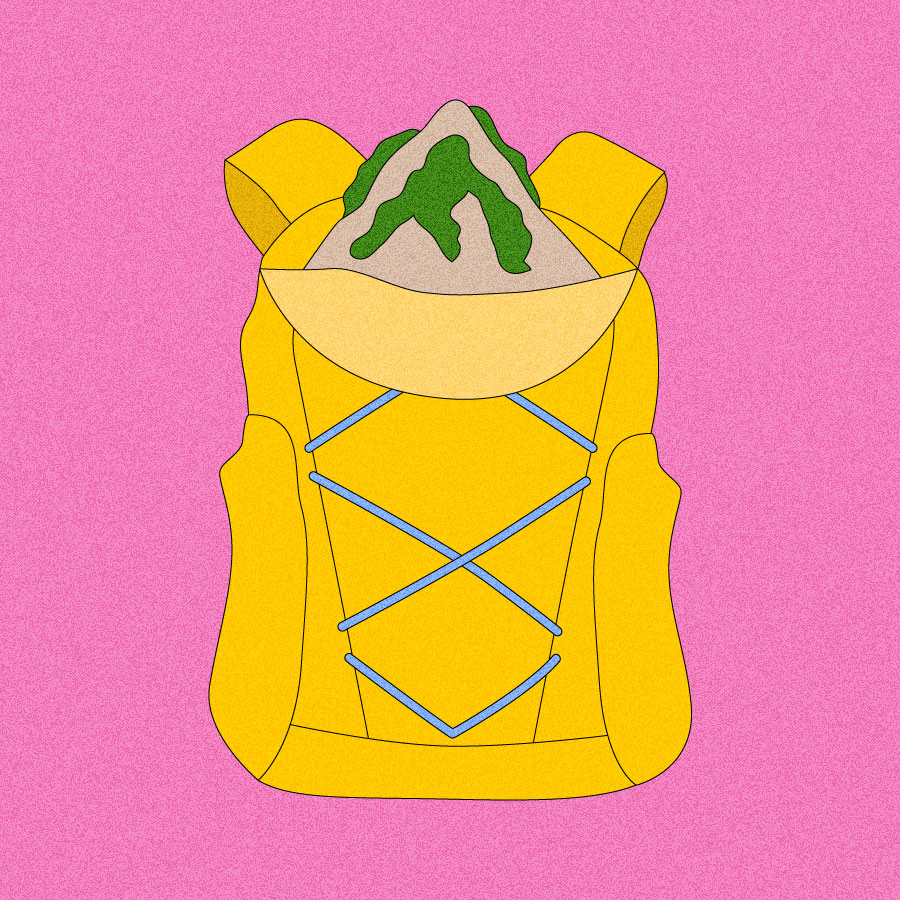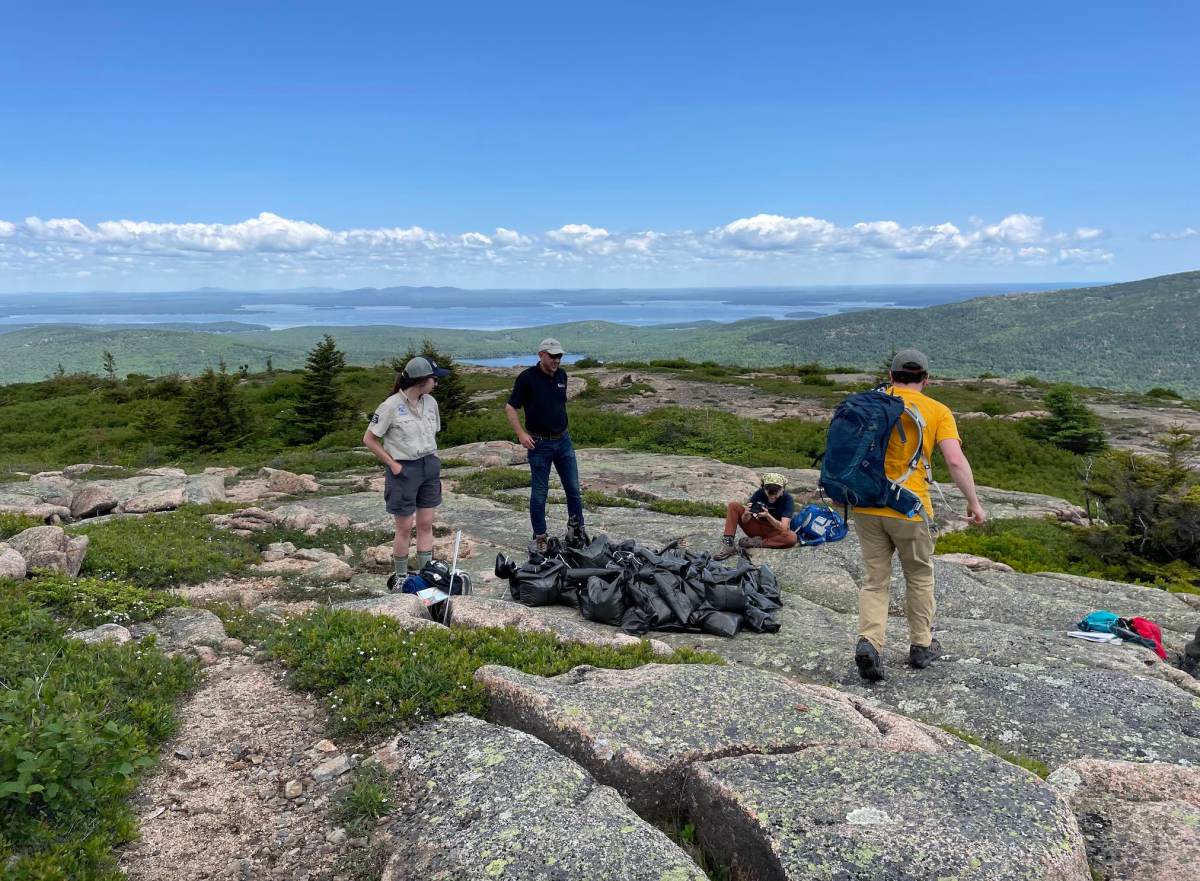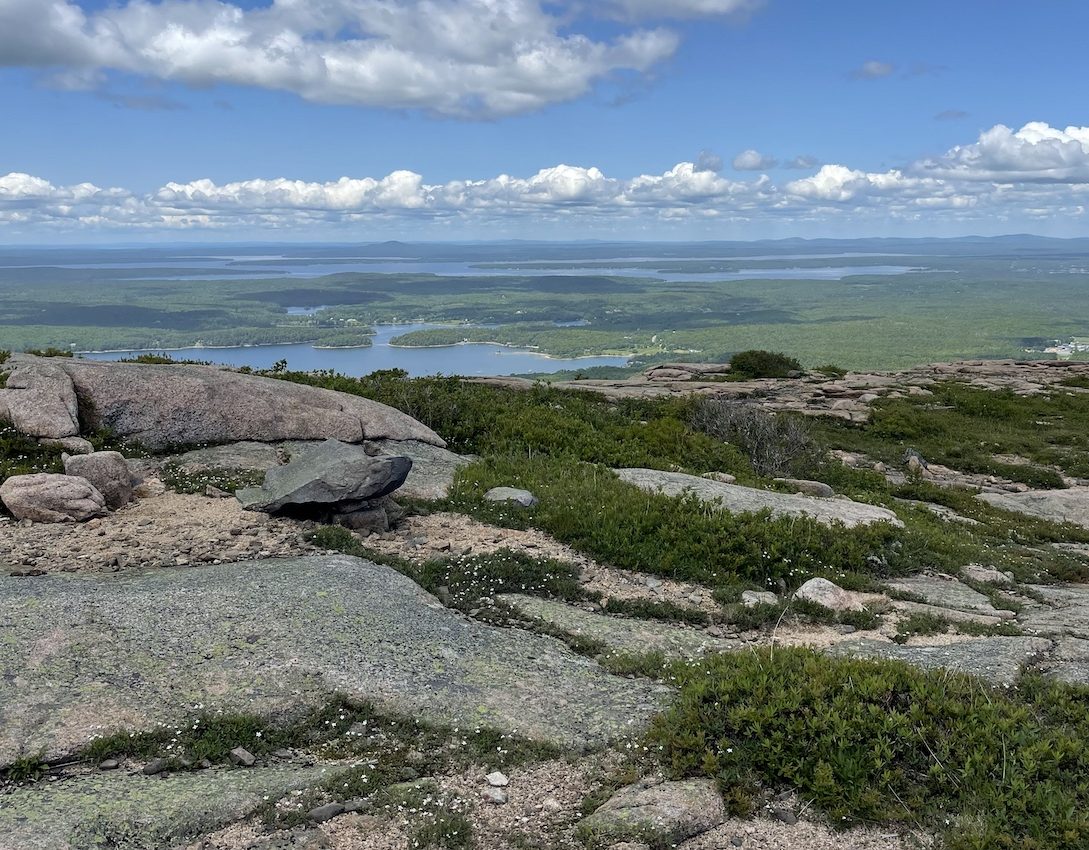
The vision
“It’s really our duty to try to figure out how we can restore these places so that the next generation of people will be able to come here to see these amazing places and see these really unique plants that really, many of them only occur on mountain summits in Acadia.”
Chris Nadeau, climate change adaptation specialist (quoted in News Center Maine)
The spotlight
The dirt in my pack made the hike a challenge. It weighed around 10 pounds, which felt manageable at first but became heavier with each passing step. The morning was dewy and temperate, typical for northern Maine. I looked around at my hiking troupe. Most of those within eyeshot were visibly older than me. As an early 20-something I did not expect to feel inadequate for the task. “How is everyone else doing this,” I wondered, cursing my dirt-filled sack and setting my mind to match in step with the others — up the steep, rocky, and buggy trail to the peak.
It was June 21, 2023 — the edge of summertime in Acadia National Park, and I was schlepping soil to help restore biodiversity to the park’s summits.
![]()
Located in the transition zone between two ecosystems — northern boreal forest and eastern deciduous forest — Acadia National park in Maine is known for its diverse topography and 26 peaks — all of which have been losing vegetation for decades, due to heavy rains made worse by climate change as well as trampling by off-trail hikers. This loss of flora has already had far-reaching consequences for the health of Acadia’s ecosystems. Mountain plants provide habitat for birds and many other wildlife, help hold soil in place, and soak up precipitation — which prevents potentially hazardous washouts and landslides.
Park managers began trying to address the issue by simply roping off fragile areas to see if that would allow the vegetation to grow back, said Chris Nadeau, a climate change adaptation specialist at the Schoodic Institute. (I am also employed by the Schoodic Institute as a science communication fellow, though I am not directly involved in this or any other restoration or research projects.) But it didn’t work. “One reason for that is that there probably isn’t any soil left in these degraded areas,” Nadeau said. So, about seven years ago, the Schoodic Institute and other organizations began experimenting with ways to restore native plants to the park’s summits.
Their research found that bringing the soil back was the key. Spreading about an inch of soil on the exposed peaks was enough to give the plants a foothold. “We needed to bring soil to the summit,” Nadeau said. “If we bring the soil, the plants will just come — they’ll colonize the soil that we bring up to the summit on their own.”
One of the major summits in Acadia, Cadillac Mountain, would be easy to work on, as it has an access road. But the two other main summits in the project, Penobscot and Sargent, aren’t accessible by car, making the effort a little trickier. The team thought about using a helicopter to transport soil, but ultimately decided it was too costly and not environmentally friendly.
But there’s another way to get soil to the top of the mountain: Carry it.
![]()
When I arrived at the trailhead, I was instructed to fill a black sack with an amount of soil of my choosing from a large pile at the base of the mountain. The hike would commence in three separate waves: 7 a.m., 8 a.m., and 9 a.m. After that, it was about an hour and 1,000 feet from base to summit. I arrived exceedingly early for the event, worried the drive to Mount Desert Island would take me longer than Google Maps told me, so I took off a hair before the first wave with some of the organizers at about a quarter to 7.
The Schoodic Institute had organized this group hike, titled Save our Summits, together with the National Park Service and Friends of Acadia. They weren’t sure what kind of turnout to expect, but around 80 people came to the event in total — older hikers, younger hikers, locals, and visitors — all showing up to carry their weight.
The hike was harder and steeper than I anticipated. Weeks of heavy rain had pounded the terrain into an earthy slip-and-slide. I focused on my footwork, trying to step on stones rather than puddles, spongy grass rather than slick rock.
The group of us trekked up the trail one by one, in single file. Hardly anyone spoke. I heard a sudden crunch — it was one of the staff members, Sarah, who had slipped on a slick rock. “My shoes don’t have any traction,” she said as she hoisted herself up and carried on.
The trail opened up to a granite ridgeline, gray and rocky and bare. It’s what I had expected, but the bareness was still alarming to see. I continued on, following Emma Lanning, the biological science technician at Acadia National Park, toward the top of Mount Penobscott. Below the balding ridge, the view from the summit was filled with soft pillows of green coated with Maine’s foggy breath.

Volunteers gather at the summit as the bags of soil begin to pile up. Catherine Devine
A kind park ranger was there to cheer me on and instruct me where to dump my dirt. “Right over there,” she said, and pointed to a mound piled high with black dirt-filled sacks. I lifted my payload from my pack and threw it onto the pile. It looked small next to all the others. I wished I had brought more.
When I asked volunteers what drew them to the event, almost everyone replied in a similar vein — “I just want to do my part,” they echoed.
“I carried 10 pounds, it was definitely worth carrying the soil to help the national park. Just a little bit always helps the park more and more, and I’m proud of that,” said Megan Huff, a senior at the local high school, who participated along with her mother and younger sibling.
“It was really fun. I mean, the hike up was difficult. I had to take several breaks but other than that, I really liked the honor of bringing soil up to help get plants and vegetation up this mountain,” said another young participant who looked around 10.
Nadeau was thrilled with the response. “It’s been amazing. I mean, people just really want to help the park,” he marveled. “In fact, we have to hold people back, people want to take way more weight than we’re comfortable letting them carry up the mountain.”
At the end of the day, hikers hauled over 1,500 pounds from base to summit — although the organizers didn’t set a specific goal for the event, they said the amount exceeded their expectations. Nadeau and his team would still like to transport about 500 more pounds to the summit to ensure they’ll have enough to cover all the degraded areas with at least an inch of soil. In the future, Nadeau plans to host a few more soil hikes of a smaller scale. “We have many, many people asking us when they can do it again. Which is cool,” he said.
“So in the fall, we’ll be spreading soil to try to fix the degraded areas,” Nadeau continued, pointing to a small granite path snaking toward the edge of the ridgeline. “We’ll go to a spot that, for example, has a little trail, and we’ll place about an inch of the soil an inch deep over the entire trail area, then we’ll cover that with this coconut mesh fiber that holds the soil on the mountain until some vegetation can grow in the soil to hold it on. And then we’ll just let that grow.”
— Catherine Devine
More exposure
- Read / watch / listen to: more about the Save our Summits hike and restoration efforts on Acadia’s peaks (New Center Maine and Maine Public Radio)
- Read: how habitat loss, driven by a variety of factors, is affecting mountain ecosystems globally (The Guardian)
- Read: a short opinion essay about restoration efforts as a growing form of outdoor recreation (Mountain Journal)
- Read: how the legal recognition of Indigenous lands has led to improved forest health in Brazil (and how forests managed by Indigenous tribes in the U.S. face a massive funding gap) (Grist)
A parting shot
A view from the summit of Mount Penobscott following the community soil hike on June 21.




